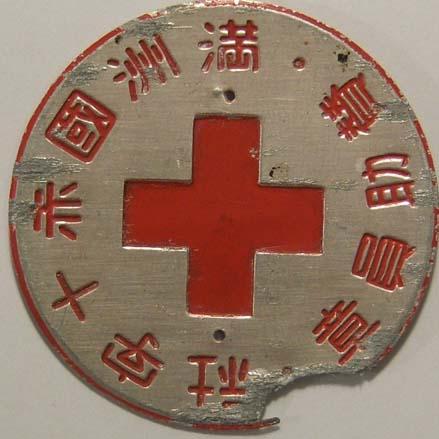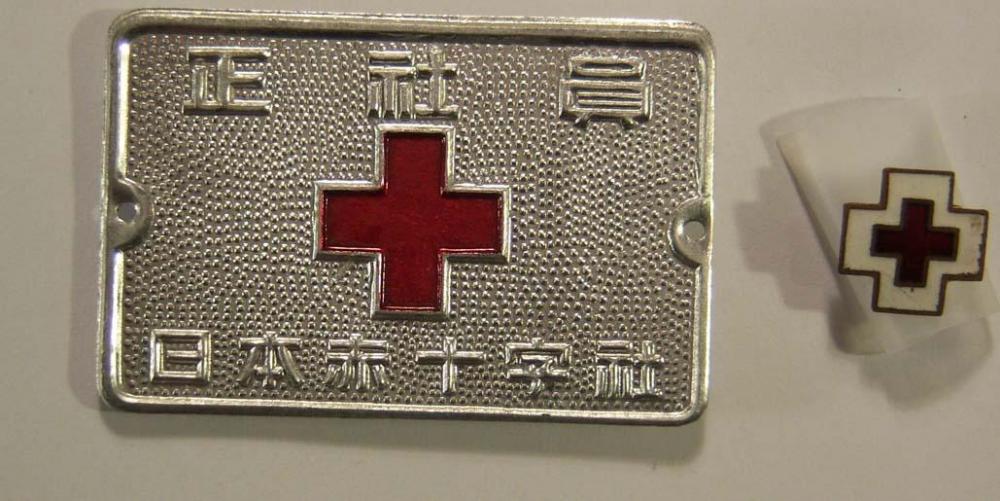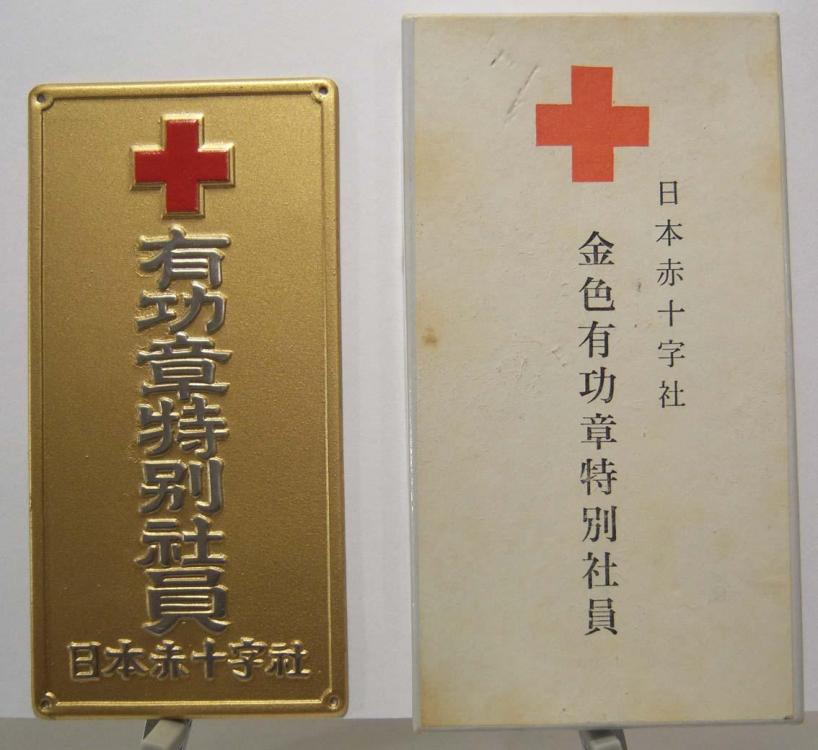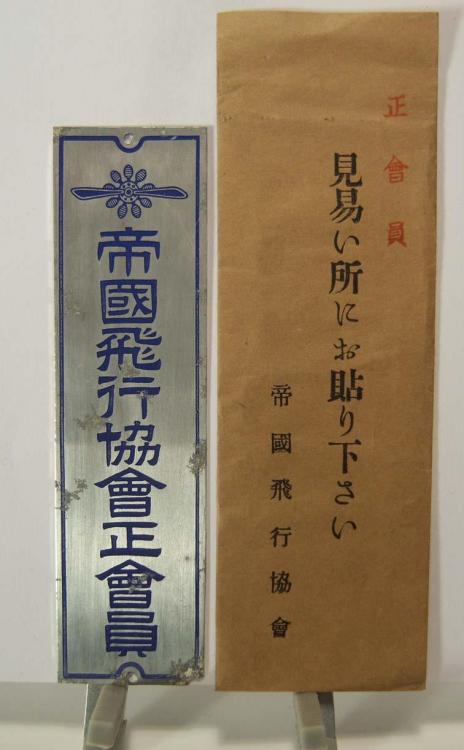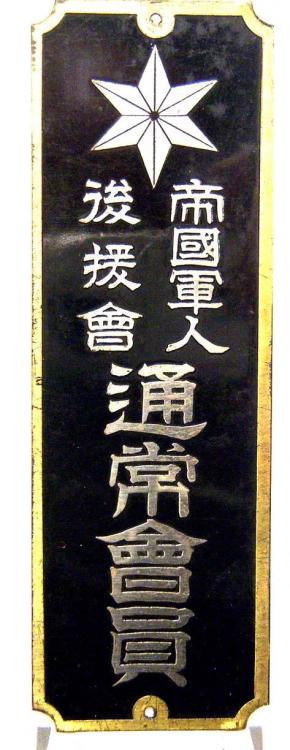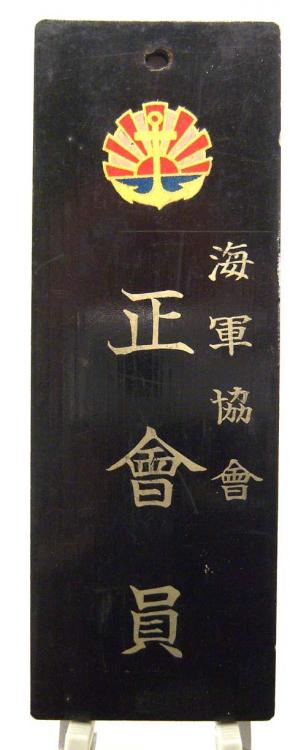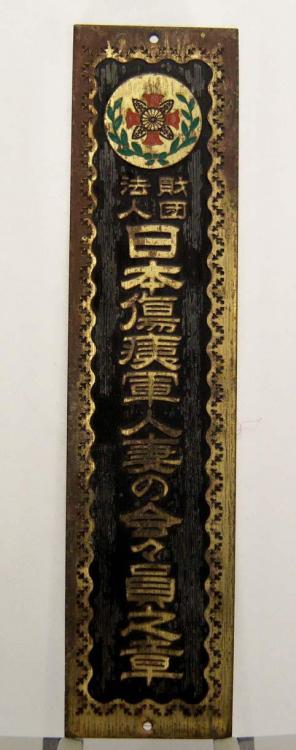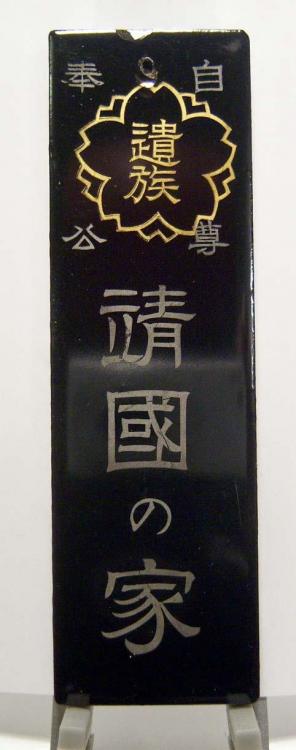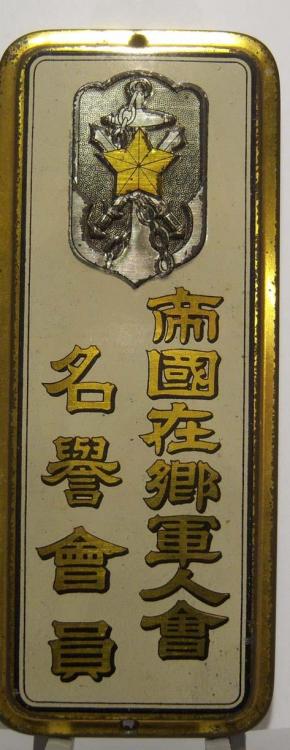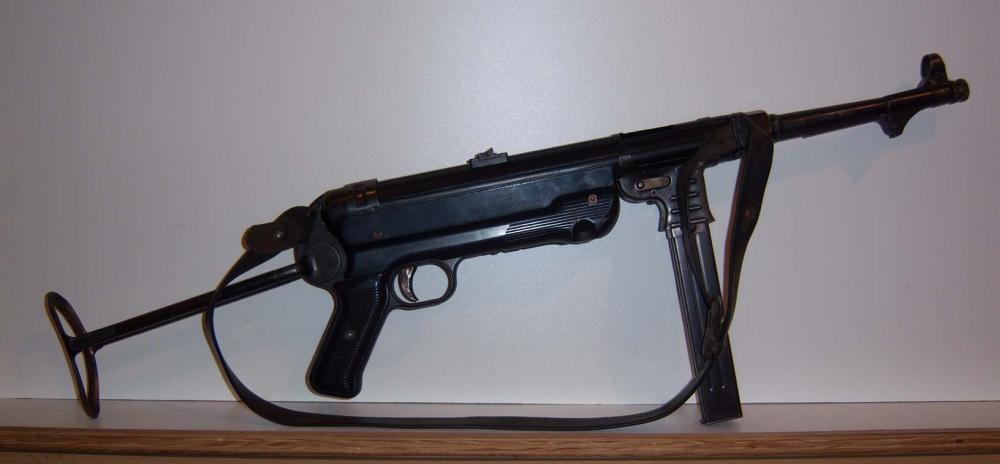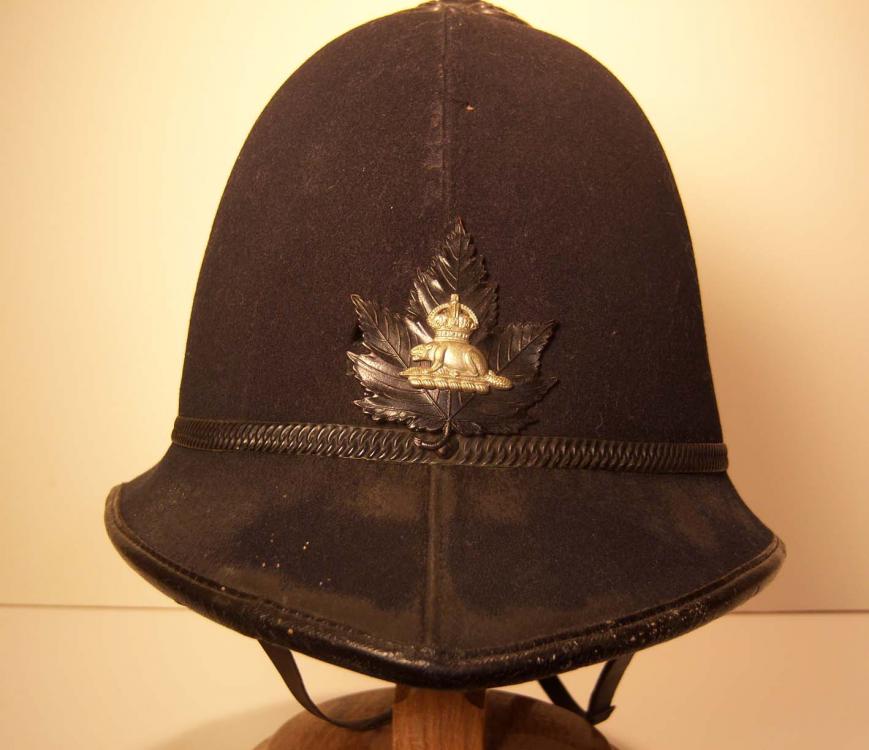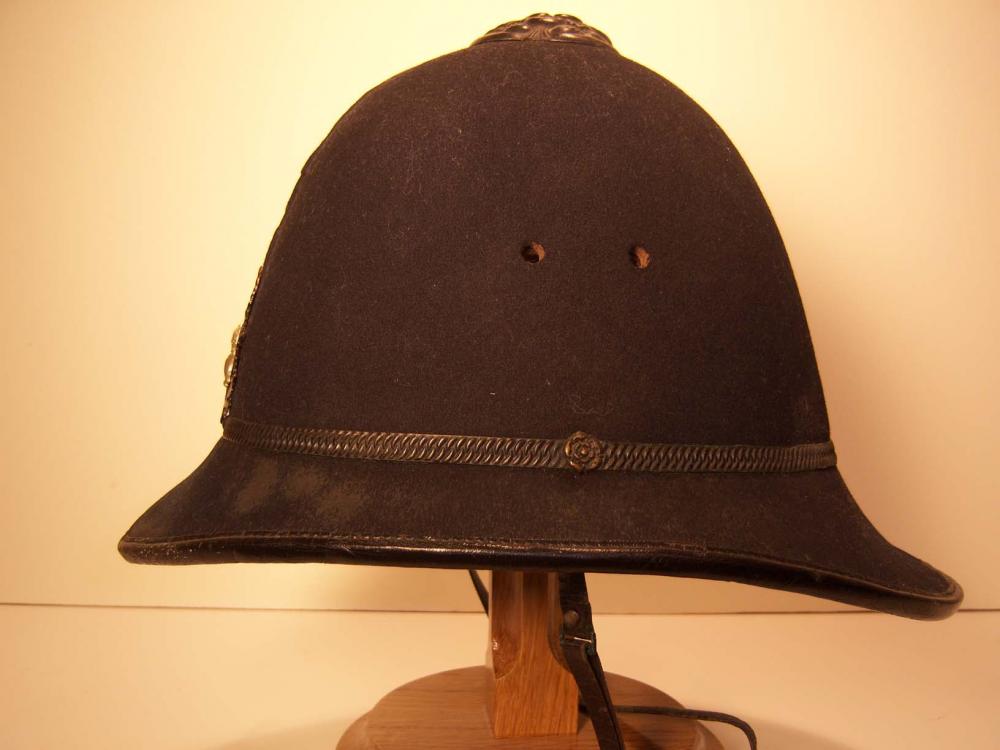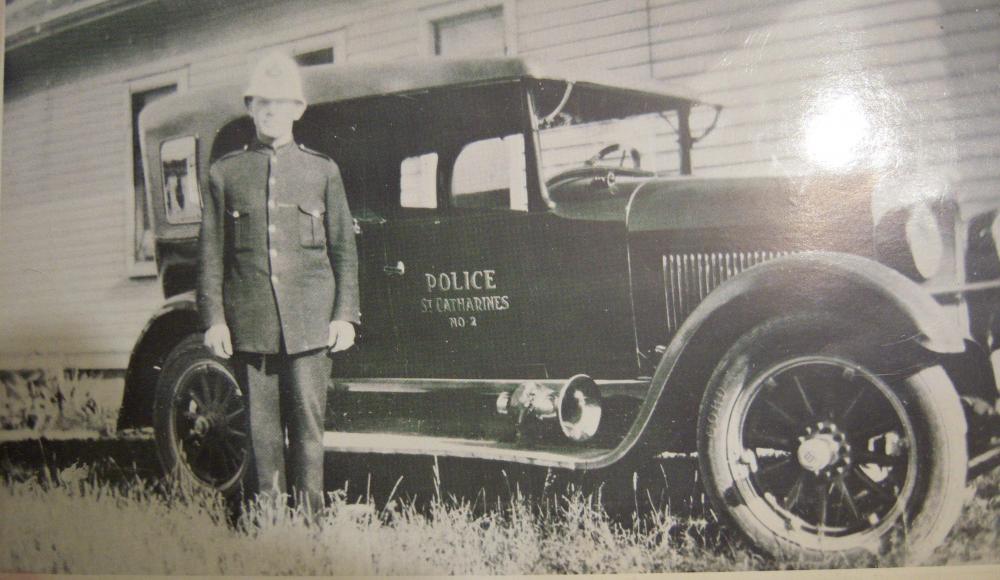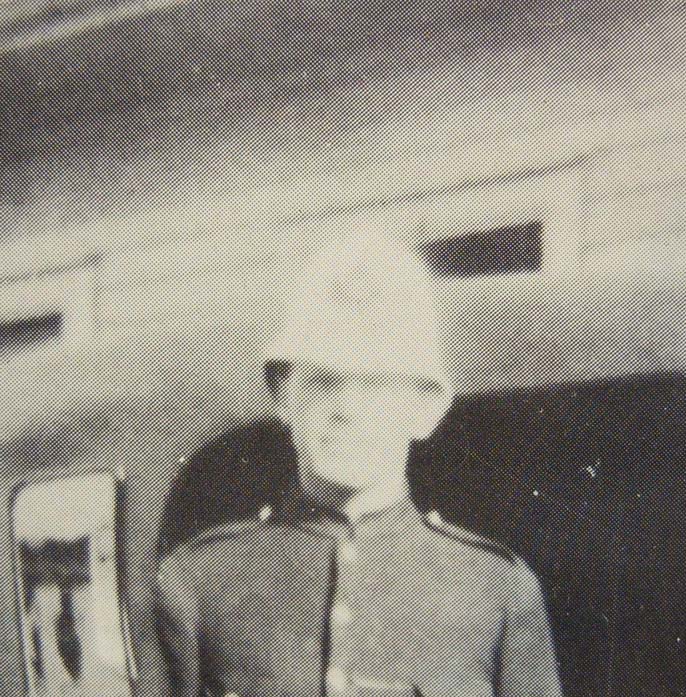-
Posts
6,486 -
Joined
-
Last visited
-
Days Won
10
Content Type
Profiles
Forums
Blogs
Gallery
Events
Store
Everything posted by Brian Wolfe
-
Supporting Member of the Manchukuo Red Cross Society 1938-1945 This is a porcelain door badge, a specimen I am very fortunate to own as these must have been quite fragile. Imperial Japanese Seafarers Relief Association (Nihon Kalin Ekisaikai) To finish off my collection here is a post war issue door badge and pin backed badge. I have other Japanese Red Cross associated items that I may post at a later date on a different thread. "Full Member of the Japanese Red Cross Society".
-
This door badge came with the original box and even the small brads (tacks) to mount it. "Member" of the Japanese Red Cross Society. This Red Cross Door Badge is made from a pressed paper product similar to the material used for today's egg cartons. "Member" of the Japanese Red Cross Society.
-
Next is a door badge for the, "Member of the Friends of the Military" This door badge is complete with the original shipping envelope. Member of the Imperial Air Association.
-
This is a wooded badge. "Member" Patriotic Women's Association (Aikoku Fujin Kai) Imperial Military Reserve Association (Teikoku Zaigo Gunjinkai) Member. This door badge is wooden. "Member" of the Imperial Navy Association This is a wooden door badge. Imperial Friends of the Military Association. Located in Ishindencho Mie Prefecture
-
Wounded Soldier's Wives Association I should have stated that most of the badges in my collection are made of a light weight metal unless noted otherwise. In this case the badge is made of wood. Bereaved Family WWII KIA "Full Member" of the Imperial Time Expired Soldier's League. "Member" of the Imperial Time Expired Soldier" League.
-
Japanese Door Badges I’ve followed this section for quite a number of years now yet seldom post mainly because I don’t have a lot that hasn’t been shown many times before. While I never get tired of seeing yet another Golden Kite much like the Iron Cross guys I rather thought that perhaps not everyone feels that way. On the other hand I haven’t been very supportive of the Japan section so with that in mind I am posting specimens from my small Japanese Door Badges collection. As an introduction I’ll quote the section from “In the Name of a Living God”, Paul L. Murphy & Steven L. Ackley, Chapter 13 as I could not say this any better. “Most of the societies whose badges as featured in this book issued door badges to their members in addition to the normal membership and merit awards. These were intended to be affixed to the home entrance to indicate that the owner was a member of the relevant society. The use of door badges continues in modern Japan although most are now in the form of adhesive stickers. The badges used before 1945 were made from a variety of materials and a sample of badges from the main organizations follow. Most door badges incorporate some society badge and the membership class representation. In some cases they also have the recipient’s name.” I have a few of these so it may take several posts to get the whole collection up, more a matter of my slow photography skills then any vast number of specimens. So please be patient. Regards Brian The first specimen (below) is, “Member” of the Greater Japan Wounded Veteran’s Association. (An early badge, 1913 – 38) Sorry About that last photo, it didn't look like our forum was going to accept Photoshop sizing and I panicked. This badge is to a member of the Wounded Servicemen's association from Chiba Prefecture.
-
Hello Everyone, After some experimenting I've come up with a way to photograph larger items. It is not what I would like but with a few portable lights I've gotten some photos of the swords mentioned in the above blog. You can see the vast difference between the Pattern 1908 (top sword) and the Japanese Katana c. 1650. Completely different designs and weapons systems. The other photo is of the Pattern 1908 and the guard's markings of R.H.G. (Royal Horse Guards) While many may argue the Guards made some bad decisions, being the highest authority, under the Monarch, they did play an important role in the history of the British military. I'm very please to have been able to add this sword to the collection. I've added some text to help you read the stampings. Regards Brian
-
Staying Sharp. Not too long ago I was attending a Gun Show in our area and had just completed a negotiation for the purchase of a Pattern 1908 British Cavalry Sabre. The guard had “possibly” been repainted green in the same shade as the WWI models, though I see no indication that this is not the original paint job; some of these were green and some a khaki colour. The seller stated that it had been issued to the Fort Gary Horse (Canadian) which to his mind warranted a slightly higher price than one might normally expect. This example, I did agree, commanded a higher value but not for the reason he presented as the guard was stamped R.H.G. (Royal Horse Guard). As a shameless fan-boy of Victorian era military, anything marked to the Horse Guard is prized. “Hold on there sunshine”, you may be thinking, “haven’t you forgotten the dates of Victoria’s rein (1837-1901) or missed the fact that the sabre is a Pattern 1908?” The Pattern 1908 was in fact accepted into service by King Edward VII (1901 –1910), rather reluctantly according to some sources as he considered it a very ugly pattern compared to those patterns that came before. I considered this specimen a real treasure and therefore was prepared to pay a bit of a premium. For a change the lack of attention to detail was not mine and I came home with a treasure, in my opinion. Granted I could have pointed out that the stampings did not support his original claim with the intentions of negotiating a lower price, however, since he felt the sword commanded a premium price and I agreed, albeit for a different reason, therefore I feel no remorse at withholding the information. A case where Caveat emptor was somewhat reversed; Caveat venditor perhaps? The Household Cavalry and I believe Royal Horse Guards still use their Pattern 1892 Mk.II for ceremonial purposes, however during the WWI period they were issued the Pattern 1908 while on active service. By way of some explanation as to why, if I am so inclined to collect Victorian era black powder military firearms and swords, have I added the Pattern 1908 Cavalry troopers sabre and the Pattern 1912 Officer’s Cavalry sabre to the collection? My collection theme, and I do have one, (a method to my madness if you will), is that I like my collection to tell a story and yet not necessarily including every Pattern of sword or Mark and Number of every musket ever made. Therefore the Pattern 1908 and 1912 is the final chapter in the story of British Cavalry sabres. Also, I do collect in the “other direction” so the collection also has examples of weapons from George III, George IV, William IV as well as Victoria, a range from 1760 to 1901 or 1912 in the case of the last cavalry (Officer’s) pattern. I find it interesting that the Patterns still in use today by Officers, though for ceremonial purposes only, end with the Victorian Patterns. One exception that I am aware of is the use of the Pattern 1908 by Canada’s R.C.M.P. in their world famous Musical Ride. Now, finding one marked to the R.C.M.P. would be a banner day indeed. After I had secured the sword I slipped it into what is called a “rifle or gun sock” for transport around the balance of the show. My reasons for this, other than treating the sword with respect and protecting it from any damage while it is in my care, is the unwanted banter that often comes from the vendors. If you carry around a firearm or sword, for that matter, every other dealer is shouting out at you asking if “it” is for sale. I find it rather annoying though I understand their reasons. Sword collectors immediately recognize the shape in the rifle sock and some will ask if they can see what you have. Naturally one would never decline to show off a new prize and the resulting conversation that follows. Eventually I came to a table of a long time acquaintance of mine who is also a fellow sword collector. He is a collector of ancient Japanese weapons and armour, the real thing not the WWII NCO and Officer’s katanas or the cheap scrap metal reproductions out of China. I showed him my latest purchase and he said, upon handling it, that it was a really poor sword and felt awkward in the hand and he thought it would also be a poor sword for fencing. It should be explained that this is common between us, his running down of British military swords and me asking once in a while, when no one else can hear, if a certain blade on his table came out of China recently. I would agree with his tongue-in-cheek assessment that the 1908 Cavalry Sabre feels much different in the hand than a Japanese katana, and he was as usual joking, as I have a couple of Japanese swords in the collection dating from the early 1650s. I also agree that the 1908 would make a terrible fencing sword based on the fact that in my younger days I belonged to a fencing club, using the epee for the most part. Then he hit upon the obvious that the 1908 had no true (sharp) edge and was “too dull to even cut butter”, I have not experimented but I assure you the butter remark was a little over the top. My friend knows his swords so his comments only elicited a laugh from me as I knew he was kidding. The downside is that he now has one up on me! This has led me to thinking about the current trend on television to run programs comparing different weapons systems and warriors throughout history. Comparing a ninja to a fifteenth century fully armoured knight for example. Who would win? First off there is no such thing nor never has been a ninja outside the realm of fiction and fantasy, so let’s call our imaginary friend a samurai. They were both in more or less the same time periods but the warfare they engaged in was completely different calling for different tactics and equipment. Also the samurai portrayed in these silly “competitions” is almost always indicative of the warriors of the 1650’s period and probably should at least be the fully armoured samurai of the 1500’s. Total nonsense! No different than comparing the Japanese katana of the 1650’s, of which I have two examples in my collection, to the Pattern 1908 British cavalry troopers sabre. Katanas are cutting, or slashing, weapons and the 1908 is a “thrust centric” sword, not even a true sabre; it’s actually more of an estoc. True you can thrust with the katana but just looking at it tells you that the principal use is as a cutter. You’ve probably seen samurai movies where the hero has just polished off 1,714 of the opposition’s samurai then flips his sword under his arm and stabs another opponent who is coming up behind him. Nice move for the camera but not one that would be very useful on the battle field. To make my point, the distance from the body of the samurai to the point of strike (about 4 inches from the tip) on the blade is 42 inches. The point of fatal contact with the enemy approaching from behind is 10 inches taking into account a needed four inches of penetration for a kill. Why would the enemy not simply strike his opponent, who is facing away from him, using a cut at 42 inches away instead of coming within the 14 inch strike range of his adversary? If you stand 14 inches away from your opponent it is almost impossible to make a power cut or even “give point” (thrust, or stab). You may simply say, “There he goes again, making unsupported claims”. Surprisingly enough, while I may blend a couple of stories together to make one better tale every now and then, I never make unsupported claims. Today was a very nice day so I went out into the back yard with my wooden practice katana (officially called a “bokken”) and my tape measure and carried out some experiments. The neighbours are used seeing to my so-called experiments in archeology. Some neighbours tend to describe me as eccentric, for some reason. There are probably less polite terms used when speaking to each other about their neighbour, I am sure. If we now look at the 1908 cavalry sword and read the history behind it we find that it was designed as a thrusting weapon only and only while on horseback. It was to take the place of the lance for the most part. It is not a fencing epee or a slashing weapon, this I assure you as I have studied and participated in both European and Japanese styles of fencing. In conclusion there is no comparison, not because one is superior to the other but simply because you can’t compare the two; they are totally different “animals”, different time periods and using different tactics. I apologize that I have not included photographs this time. I am not set up for photographing larger items and had a lot of trouble when I tried to insert Photoshop reduced backgrounds (canvas). Regards Brian
-
Hi Stuart, That may be, but what a collection you have! The term "World Class" comes to mind. Regards Brian
-

The Value of a Collection
Brian Wolfe commented on Brian Wolfe's blog entry in News From the Home Office.
Hi Veteran, Thanks for your comment. I think if my family were to sell it after I am "gone" (and they will) they would be lucky to get 50% of the worth. However one can hope. Regards Brian -

To The Point, Part 1
Brian Wolfe commented on Brian Wolfe's blog entry in News From the Home Office.
Hi Rick, Thanks for your comment, all well here, though perhaps I need to find my own friends rather than always going to my wife's friend's functions. Regardes Brian . -
To the Point, Part 1 British Edged Weapons Problems. Getting Bent. Yet another function where my attendance is somehow mandatory, seated at a round table with barely room for five couples none of whom I know; if I did get to know them I am confident I would not like their company. Men in suits that look like they originally belonged to their fathers with dress shirts that are so small that the top button can only dream of ever being reunited with its intended closure. A failed attempt to hide up the fact that the shirt is far too small made by disguising the open space with the large King Edward’s knot reminding one of a convicted felon, neck in the noose, awaiting the final drop to oblivion. Then there is the inane conversation. The ladies content to swap stories of grandchildren and the men struggling to find a mutually respected sports team. My wife has cautioned me on several occasions about my conduct and what I should and should not say or discuss among those of whom I am unfamiliar. To the question as to whether I follow or have an interest in a certain sports team I now simply say “no”. Apparently this is preferable, according to my spouse, to replying with, “not in the least”, to the sports question. Personally I can tolerate those with single faceted, career related, interests at least they can be interesting and there is a slight chance that one can actually learn something new, making the sacrifice of my time, a finite commodity, somewhat worth the expenditure. I like to hope that at least a couple of these posturing male gorillas attempting to establish themselves to be the alpha silver back has enough intellect to avoid metaphorically throwing their own feces and even accidently offering up a topic of interest; but sadly, no. It’s not that there are no topics that I could be engaged in to discuss, even debate. Of course history, but also science and the feared taboo topics of politics and religion, both of which I am quite capable of carrying on a civilized, or a more heated, conversation. Finally there is an oasis in the midst of this sea of banality, the “seven minute lull”. It has been said that during any conversation, I suspect even more so during trivial banter, there will be a lull in the conversation every seven minutes or so. It is times like these that I find myself wishing there was a terrorist waiting in the lobby ready to rush in, encased with explosives, screaming some ridiculous babble, intent on ending our existence. Oh, would it were so. I assure you that I would run up to this fanatic, hugging him, pulling the detonator pin myself; but, again, sadly no. Just prior to the so-called lull and my wish for escape, any escape, someone said, “The problem with today’s society is social media”. Eureka, the topic for this month’s blog suddenly came to me. No, no, not today’s social media as my “world” is the mid to late 19th century; it is the media of the Victorian times and in particular the “fake news” (yes, I know the modern reference) as it pertained to the British military swords and bayonets of the day. Oh, yes, the topic of what is wrong with the world today quickly deteriorated into what was wrong with today’s youth. From what I see today’s youth is basically not a lot different from the youth “of my day”. I just may not have yet reached the age where I am convinced that I know what the problems of today are and especially how to solve them. Though I suppose some people are wise beyond their age; yep, sarcasm. We are all exposed to today’s media, be it through the handheld devices, laptop, PC, or traditional media. It is apparent that some sources are very bias toward a certain political idealism or popular consensus but while we may think we “own” this phenomenon as it seems so relevant to our times it is nothing new. Reports back to the home front from military actions, for example, have been common place for centuries in the form of official war diaries and more “as it happened” journalism through war correspondents. In the mid to late nineteenth century war correspondents were often “in the thick of it” during battles such as the Zulu and Sudan campaigns. In the case of the Sudan campaign, the Battle of Abu Klea 16 January 1885, some of the war correspondents defended themselves during this vicious battle with their privately purchased revolvers. As a point of possible interest an ancestor of mine, Lieutenant Richard Wolfe, No. 4 Co., HCR/Scots Greys, lost his life defending the British square during this battle. As I have stated above some of the news papers of the time were very quick to point fingers, as to blame military failures, on the political party in power, in particular the Prime Minister. It was found that some of the swords and bayonets failed to perform as needed during the fierce battles often resulting in the death of the British Officer or soldier. This resulted in what was called the 1885 Bayonet Scandal. Basic blame was placed on the poor quality of the swords and bayonets used by the troops. In the case of the Officers they purchased their own swords as opposed to the NCO and other ranks who were issued government supplied weapons. At the time many sword blades were made in Germany and then sold to sword makers in Britain who would then finish the sword and sell it to the government for issue to the NCOs and other ranks, then swords for the Officer class were sold to retailers for private purchase. Some of the tailors, or retailers, would even place “proof marks” on the ricasso as if the sword had passed testing and were therefore “battle ready” which many were not. The “scandal” resulted in the testing of swords and bayonets already in the hands of the military as well as those in stores. It was found that a large percentage of weapons failed the trials; in the case of the socket and sword bayonets for the Martini-Henry this involved both the bending and twisting tests. One of the early excuses for the failure of bayonets in the field was the accusation that soldiers used their bayonets as pokers to keep camp fires blazing. This was a “smoke screen” used by authorities to hide the testing results and associated blame from the public. An article in The Times, 13, January 1885 discounts this quoting an army source as saying, “Any use of a bayonet as a poker would not likely pass inspection the following morning”. This served to discount the original accusation. While the contractors who produced the sub-standard bayonets were never officially named there were two factors uncovered by the investigation in the manufacturing process that caused the defects. “Firstly, the bayonets were all subject to bending tests and, so that the contractor could get the bayonet passed, he left them unhardened. This was necessary because, if hardened, they would break under tests, as inferior steel was used in the manufacture. The second reason was that some contractors used casehardening so that when bayonets were manufactured they were ground, then hardened and were then passed on for final grinding. If the bayonet was not much oversize then the bayonet would probably be all right, but if it were too much oversize all of the casehardening would be ground off, leaving the soft metal.” Source: “British Military Bayonets from 1700 to 1945” by R.J. Wilkinson Latham. The Patterns involved in the scandal, the Pattern 1853 sword-bayonet and the Pattern 1876 socket bayonet, were replaced by the Pattern 1886 which brought to an end the problems experienced. Future sword and bayonet manufacture was dominated by the firms of Wilkinson and Mole and manufacturing of weapons from firms in Germany ceased. In this blog we looked mainly at the British bayonet and the associated scandal, in next month’s submission (Part 2: Staying Sharp) we will discuss the earlier problems with the British Cavalry swords, in particular those used during the Indian Rebellion of 1857 (also known as the Sepoy Mutiny). Regards Brian
-
Thanks Paul. Regards Brian
-
Sorry for the delay in responding, it is garndening season here in Ontario and I got completely distracted, even more the advancing age usually causes. I thought I responded to your comment, JustinG, and you replied but I don't see it here so I either imagined it (age again?) or the posts have gone astray. I do like your avitar as it shows imagination in that it reads "to the rescue" and I understand it is a reference to your career. Well done! At times I think that I use my real name mostly because I lack the imagination to come up with a good avitar name. I can't seem to come up with a name or title for my collection room. Some fellows call their collection room their bunker or man cave etc. but all I could come up with was "collection room". I do call my office "The Home Office" as not only is it my office in my home but also a reference to the British Home Office, not that I served in the British Police Service but as more of a tribute to those members who have and or are serving there. Strange that we don't think to thank a cop for his or her service even though they could be putting their lives on the line every day over what could be a career spanning decades. So to all the police officers everywhere, "Thank you for your service". Back to original or catchy names for a collection room, since I have expanded the collection into three rooms I now have a greater problem I still call two rooms, the collection room and the home office but the middle room just got "the middle room" as a name, how unoriginal was that? Hello Stormy, I must say that your avitar name is one of the best stories regarding avitar names. What can I say? I think I recall that you have mentioned that before on the forum, quite a while back. I would use the name of my ex as an avitar name but the rules of the GMIC forbid swearing. Regards Brian
-

Iconic Firearms - what do you think?
Brian Wolfe replied to Brian Wolfe's topic in Firearms & Ordnance
Germany’s MP40 No other firearm is as iconic with WWII and the Third Reich as the 9mm submachine gun, known as the MP40. Designed in 1938 by Heinrich Vollmer it was heavily used throughout WWII on all fronts by infantry and paratroopers. Due to its relatively slow rate of fire, 500-550 rounds/minute and using a light round, the 9X19mm parabellum round it was a very accurate weapon. Like most sub machineguns the range was fairly limited with an effective range of 100-200m and a maximum of 250m, however within the effective range it was quite deadly. The specimen shown is from my collection. Regards Brian -
I Hate Moving! It has taken a while but the Home Office has moved two doors down the hall and the vacated room is now converted over to a second collection room. My dear astute wife is starting to suspect a form of Lebensraum is taking place within our home. She has countered my resent move, generated by the need to expand my territorial claims, with a policy of her own which states that she will concede the space but this is the last time appeasement will be offered before some undisclosed action is taken. I have assured her that if this latest claim is granted then I will make no further territorial claims. Of course the agreement was written on a piece paper which she proudly waved to the family proclaiming that there was to be peace in our time. This is strangely starting to sound familiar. Like the size of most collections mine has waxed and waned over the years yet continued to survive in one form or another to the point where the space is filled and a move was necessary. You will notice, as did my dear wife, that the option to sell off large sections of the collection never seemed to enter this equation. To be fair I have reduced the collections somewhat in the past couple of months, getting rid of a lot of “smalls” both military and non-military antiques. Naturally some of the items were used in trade for other collectables and the cash realized from the balance of the sold items was quickly rolled over into even more military collectables. My latest obsession is a renewal of an old passion for British military swords, specifically Victorian and older. So while at first it might have appeared that I was indeed reducing the size of my collection (my initial intention) as soon as the cash was in hand something took hold of my better judgement and more items were secured. The other factor that foiled my good intentions was that the items traded and sold were indeed “smalls” but the items I gained in their place were swords; so not so small. Even though the move was not of any great distance there was the usual complaining from the staff here at The Home Office. The computer needed to be moved and hooked up and book cases relocated, new sword racks constructed and a lot of rearranging so that neither collection room looked too sparse, though the new room (former office) has ample space for a couple more years of collecting available. A large and very comfortable arm chair was “liberated” from the family room and after turning it on its side, with a lot of manipulation through the door way, found a new home. I doubt this chair will be reclaimed by the family as it was very difficult navigating it into the room, though it may end up costing me for a new chair to replace the vacant spot in the family room. Perhaps they won’t notice. Since I seldom post photos of myself or the staff members here at The Home Office I decided to make an exception this time, especially for those who wonder if there really is a Home Office complete with staff. The photo below is of us and our move and a second photo thrown in just for fun shows a group of friends at a military show contemplating the purchase of a new addition to one of their collections. The fellow looking on from the right hand side of the photo seems to have done well, scoring some nice Swiss military equipment. Well done! That’s all for now as I am going into the new room with a cup of coffee to relax in the arm chair and admire the new additions to the collection. Happy collecting. Regards Brian
-

The Value of a Collection
Brian Wolfe commented on Brian Wolfe's blog entry in News From the Home Office.
Hi 2dresq, Thank you for your comment, all very valid points. As you said you can't take it with you and unless my health fails and the kids put me in a "home" I'll be collecting until I stop breathing. Then again if I am on life support and assisted breathing I will be collecting online. The photo I included is of only a portion of my collection as I felt I needed to add some sort of photo with this blog. At least this time it was more relavent than usual. You have also hit on the very thing that makes the GMIC a great place to belong to in that we do make friends here, and many of them long term friends. By the way I really do like your avitar name, very cleaver and leaves me wondering about the inpiration for its creation. Well done. Thanks again for your response. Regards Brian -

Group to Swr./L.D./C.L.D./Nb.Ris. J.S.Sandhu AC
Brian Wolfe replied to Brian Wolfe's topic in South Asia
Hello anand singh, Thank you for your comments. I just checked the naming of these medals and the 9 year medal must have been impressed incorrectly as it is indeed CLD. Your suggestion certainly would be the logical progression in rank. I will make the changes to my records. Many thanks. Regards Brian -
The Value of a Collection A lot is said by collectors as to what their collection is worth. Last month I threw out a subject for dialogue regarding the use of avatar names on the Social Network sites and one of the comments was in regard to collection value; more specifically that there is a need for anonymity to help prevent theft. This is a very valid point indeed and one that could generate much discussion on its own merit. It has been pointed out that one may even discover someone’s identity if they use an avatar on eBay, for example, and their proper name here on the GMIC. This may be accomplished by paying attention of what is in the background of the picture of the posted item for sale then noticing the same background here on this forum. I’ve seen this myself in regard to one of the GMIC members who also sells on eBay, though I only know his real name as we both have been members here for a long time. I am also guilty of this in that I used to sell a lot on eBay and always employed the same grey corduroy back drop cloth in every photo both on eBay and on the GMIC. I usually wait until later in a Blog to get sidetracked but this time I started with being distracted, though it may be argued that it was after the first paragraph when this blog went off the rails, so-to-speak. I leave that up to you. One comment, last month regarding security started me thinking, which is the very reason for these Blogs, about my collection and the attractiveness to criminals that it might present. I do have a security system but not of the James Bond laser, poison gas type. The concept that someone could easily cut the phone lines just outside of the house has been eliminated when I built a shop attached to the side of the dwelling. The lines all remained in the same location and the shop was built over them so the lines are eight feet below the surface of the yard and enter the dwelling inside the shop. We live in a small community and an extremely quiet neighbourhood where the biggest event of the year is when the first robin arrives back from the south in the spring. So it is a fairly safe and secure neighbourhood in a small and low-crime town. This left me with looking at what my collection was actually worth and with this exercise came a rude awakening. Exactly what is any collection worth? Certainly if you have kept good records of the amount paid out for your collectables you could state the cost of a collection. Probably a figure best kept locked away in a secret safety deposit box and the key hidden from your spouse. What you paid and what it is actually worth are two completely different figures. If a criminal broke in and was able to steal whatever they wanted what would they take? Firearms would be on the top of the list I am sure and then anything they could easily sell, usually to support their drug habit. Unless you have diamond encrusted military awards or solid gold medals the criminal may have to sort through dozens, perhaps hundreds of military medals in order to take only those made of silver. Keep in mind most thieves are “grab and run” types and do not take the time to sort, especially if an alarm system is blaring away. Most pawn shops are hesitant to take in any quantity of so-called collectables, though anything that could be easily melted down may be more desirable to the less honest pawn shop owner. I would say that electronics would present a more attractive target than 200 bayonets, even with their original scabbards. Moving on from the possibility of criminal activity because you have either taken precautions to “harden the target” (police terminology) or preserved your anonymity by not allowing every Tom, Dick and Harry in to see your collection, let’s look at post mortem sales. This may be the fate of a lot of our collections. Certainly our own mortality is not in question; unless you have found out something I haven’t. If you have, sharing it would be much appreciated. So here we are in a state of personal extinction, dead as a dodo bird and securely under six feet of dirt, with your collection in the hands of your heirs. I have found that spouses and family are fairly quick to dispose of the deceased collector’s hoard. It is not because of greed and the desire to pick the carcass of the estate clean, in most cases, at least in my opinion. It is a time of grief and your collection is a small part of the whole issue at hand. One should never discount how much your hobby has irritated the family and their point of view may not be that of the selfless parent or spouse but rather has always been a silent point of contention. There may be a small bit of resentment over the time and money you have lavished on your collection, time and attention, if not money, that could and should have been spent on them. This could be a moment of self-reflection for me, if it were not for my deep seated lack of empathy; my dear wife calls me her, “cold hearted old bastard”; that rather sums me up on so many levels. In retaliation I call her, “yes dear”. Perhaps that should make me even more reflective but, nope, it doesn’t. I’m sure my collection will be sold as soon as they can pry it from my cold dead fingers. At least I hope they will wait that long. So you are gone and your heirs go to a dealer or two and offer your collection for sale. What could they expect to see out of your “investment”? We’ve all heard such discussions between collectors and it usually goes something like this, “Those @#$%& bastards (dealers) will only give you ten cents on the dollar”. With this in mind I asked around and found that the range from those dealers who would actually offer an estimate varied greatly. The highest was from an American source at 60 cents on the dollar with the average here in Ontario at 20 to 25 cents on the dollar, Australia came in around the same as here. Bear in mind that any dealer must consider the purchase of a whole collection as a long term investment tying his money up perhaps for years. The highest estimate was from a collector/dealer with the lowest estimate from a dealer with a “brick and mortar” shop and therefore with the highest amount of overhead to cover monthly expenses. The average came from dealers who set up at shows with little to no overhead. Looking over my own collection, which includes firearms (all deactivated except my muskets, they are all in working order), I realize that I have two room filled with history’s unwanted junk. Obsolete tools of war and medals to persons long gone that tell no real story on their own. All items that any self-respecting thief (an oxymoron is I ever wrote one) would not risk his freedom to take. This, you may think, would be a bit sobering, even depressing for me and it would if I weren’t so self-absorbed and believed my collection is indeed my treasure trove of historically significant objects. So what is your collection really worth? To others perhaps an average of 40 cents on the dollar for your investment but more importantly to people like us it’s priceless. Happy collecting! Regards Brian
-
Thank you for your comments "E". One of the issues I have problems with, keeping in mind that my wife says that I am the most paranoid person she knows, is allowing anyone to view my collection. Unless the person in question has been known to me for quite a while and we have built a relationship based on trust I simply am not interested in "showing" my collection. Most of these trusted friends are fellow collectors of like mind when it comes to security. There are those who might look at my deactivated automatic weapons collection and then through the telling and retelling of the story gets to the "street" as this crazy old guy who is sitting on a pile of working machine guns. Not a story you want to be told around the wrong crowd. The crazy old man part notwithstanding. I know of one fellow who will change his avitar on a regular basis because he has a following on the internet and is seen, rightfully so, as an expert on one particular brand of sporting rifle. He is known as Mr.(the band name of the company) and other collectors watch the on line auctions and if he is a bidder they know the item has to be rare. This drives the closing price up. His changing of his avitar is not so much security as it is economic, which is still a good enough reason not to use your own name making it even easier for others to watch your movements. On a more positive note. One evening a decade ago the phone rang and it was a fellow GMIC member calling me from the other side of the word wanting to speak with me in person, so-to-speak. He had easily traced me though the internet. The fellow and I have been very good friends ever since, communicating several times a week through email and once in a while through Skype. I will leave this entry with the thought that using your name rather than an avitar is not completely a bad idea; nor is it totally a safe one. Regards Brian
-
Thanks for your comment Ulsterman, All good points from the membership and ones I would agree with completely. I recall that incident you have mentioned, not the high note in the collecting world to say the least. Using my own name certianly makes me think twice about blurting out some comment that I would regret later. On the other hand if I decided to "take on" a knob such as the one you mentioned it would be without reservatiion. For the most part those on the internet out to do harm are rarely worth the time to get into a confrontation, I just can't be borthered to put in the effort as they are not worth my time. Regards Brian
-
When I first read this post I thought to myself that I have a Canadian police helmet and photo that the members in this section might find interesting. It has literally taken me this long to locate the photo to show as proof of sorts that the helmet and badge belong together as one can alter any helmet to support a claim. I should not refer to this post as a “claim” as I am not claiming anything only showing what I have in my collection regarding the helmet plate versus the hat badge in use. I agree with everything that has been said here by people obviously more informed than me. No, I am not stroking egos here, just facing facts that I am in unfamiliar waters. So please be kind when you respond as I propose no argument. A number of years ago, possibly more than a decade past I was in an antiques shop in Barrie Ontario and saw a police helmet with a Canadian police hat badge attached. At lease I assumed it was a hat badge as it was too small to be a helmet plate. Beside the helmet was a photo of a police officer standing beside what I believe is a 1925 Studebaker. The officer is wearing a police helmet with a small badge, perhaps a hat badge affixed to the helmet. The dealer made no claim as to the helmet’s authenticity and from our conversation it was clear he knew nothing about police collectables, nor really cared for that matter. The photo he claimed came from St. Catharines Ontario and the police sign on the door supported this. He did say that the helmet came from the same “pick”. I hope the photo of the officer is clear enough to make out the badge. I am not sure why the helmet looks white perhaps a trick of the camera; my background in the helmet photo was white so as you can see cameras can be fooled. Perhaps St. Catharines Police Dept. used white helmets in the 1920s I have not researched that as I placed the photo in a box shortly after I purchased it and it has remained there ever since. The helmet was not over priced however the photo did not come cheaply at over four times the price of the helmet, making the helmet almost like a bonus for purchasing the photo. The helmet appears to be of an older style from its side profile as well as the inner parts being only a leather sweat band and attached chin strap. There are attachment holes and a faint outline of a former helmet plate from times past. If this is an original helmet then I would speculate that the helmet plate may have even been Victorian and after she passed way it was replaced, eventually, with a Kings Crown hat badge; perhaps as a money saving measure. I would think the forage hat with its smaller badge was at least in the planning stages as a replace the old helmets by the early 1920s. I hope you all find this interesting even though it really proves nothing unless it is that in collecting almost anything can happen. Regards Brian
-
Hi Chris, "I use my pic as I am the lord of the rings :-) " And yet your wife has the ring that rules them all. You make a very good point and perhaps that alone condones the use of avatar names. The internet is full of people hiding behind their avatars while launching an attack on another's view point, religion or race. This was the point I was going for however your view is quite valid. From now on I am changing my avatar name to, "Not Brian Wolfe, some other guy not to be confused with the Brian Wolfe you might think it is". Too long? Regards Brian (or maybe some other fellow)



